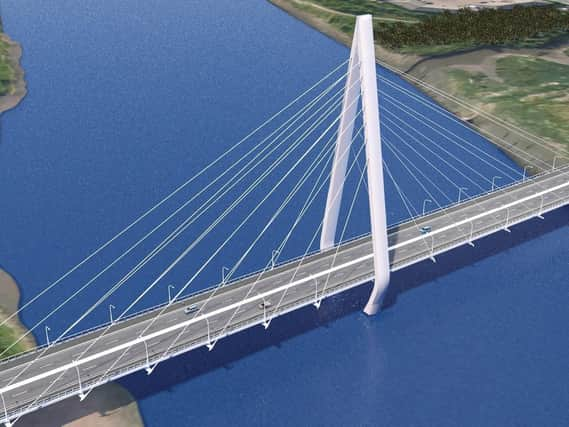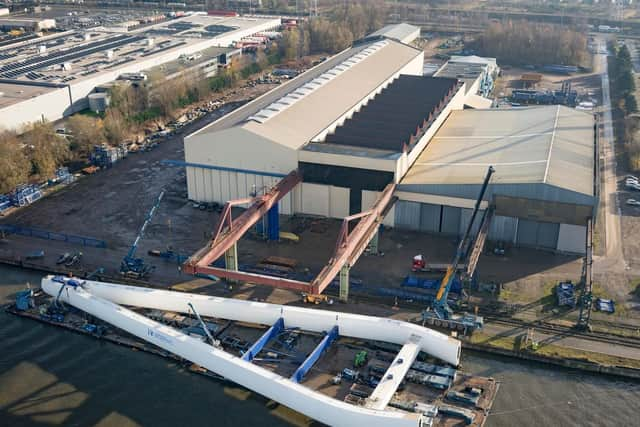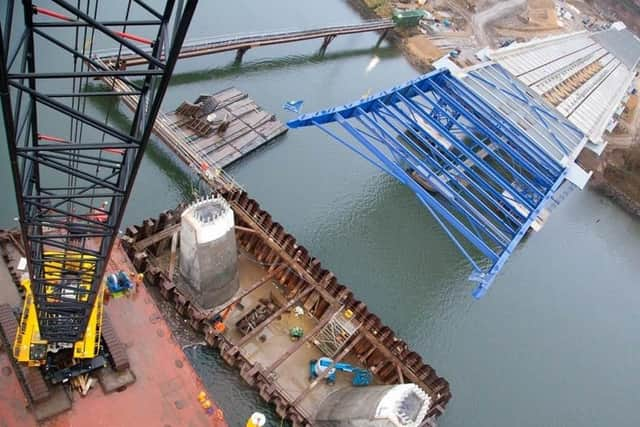Big Benny, 125 double deckers and a two-year plan: how the New Wear Crossing's central pylon will be raised


The pylon will be raised using a mix of tried and tested lifting methods and technologies.
The operation will start tomorrow morning and finish during daylight, to allow the team to carry out important checks and tasks in the natural light.


Advertisement
Hide AdAdvertisement
Hide AdThis means that as the operation will not continue through the night, it may be slowed down to ensure completion occurs at the optimum, preferred time, during the following day.
The pylon is made from 1,000 tonnes of steel and 550 tonnes of concrete and there are several key components being used to raise it into position, which will be visible throughout the operation.
What is being used to raise the pylon?
Giant hinges have been used to attach each leg of the pylon to the tusks that are built into the riverbed foundations to support the pylon. The hinges are fixed together to


hold the pylon in place and will enable the pylon to be rotated into a vertical position.
Advertisement
Hide AdAdvertisement
Hide AdThe backmast – a 50-metre high yellow, crane boom has been temporarily fixed to the pylon for the raising operation. It is being used to create an angle between the
cables and the top of the pylon, which will allow the pylon to be pulled upwards.
The crane boom has been taken from Sarens’ SGC-120 super crane, affectionately named ‘Big Benny’, which is one of the largest cranes in the world, with a lifting


capacity of 3,200 tonnes.
The cables used to pull the pylon into position – also known as strands – are connected to a blue spreader beam, which in turn is connected to the top of the pylon. They pass through four hydraulic strand jacks, anchored 30m into the ground on the south side of the river.
Advertisement
Hide AdAdvertisement
Hide AdThe cables are drawn through the jacks in order to pull the pylon into a vertical position.
Similarly, there are two hydraulic strand jacks located on the north side of the river that act as a counter-balance to those on the south side, to ensure a steady operation.


The process
Planning for the raising operation began two years ago, with the process calculated to the nearest millimetre. Throughout the lifting process, the pylon will be continuously monitored in
line with expectations for each phase of activity.
The strand jacks, initially with the backmast, will be used to raise the pylon – up through most of the lift – until the pylon reaches an angle of about 70 degrees, which will be three
quarters of the way through the operation.
Advertisement
Hide AdAdvertisement
Hide AdAt this point, the backmast will automatically disconnect from the cables, and the strand jacks will continue to draw the cables through, pulling the pylon up for the remaining 20-
degree rotation to its final vertical position.
As the pylon approaches its final position, the backmast will be retracted to stand vertically alongside the pylon and the north side cables will be tensioned to ensure the pylon is
supported from both sides until it is fully secured. Once the raising is complete, the backmast will gradually be removed and lowered to the ground and work will begin to secure the pylon permanently to the tusks.
It will take three weeks of intensive work to ensure the pylon is fixed in place.
Advertisement
Hide AdAdvertisement
Hide AdEach leg of the pylon will be fixed to one of the tusks with 20 bolts, with each bolt measuring 6m long by 65mm in diameter. A total of 40 bolts will secure the pylon in position.
After the bolts are fitted, tensioned and the gaps grouted, the base of each leg of the pylon will be filled with reinforced concrete. When all of that is complete, the rigging and cables
used for the raising will be released.
The pylon will then become free-standing until the bridge deck is launched into place in the spring and the cable stays connecting the bridge deck to the pylon are positioned and secured over the summer.